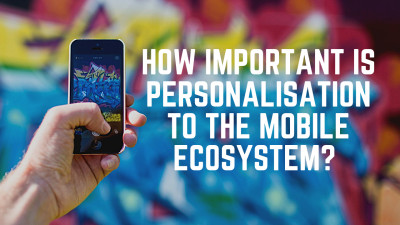Personalisation Vs privacy: The important pointers for the mobile ecosystem
The pandemic saw digital activity increasing across sectors with even traditional brands joining the digital race. Projected growth of the digital sector for the next two years was achieved during the lockdown months and now, digital and mobile take a bigger slice of the media pie.
Mobile penetration in the nation has been continuously growing and according to a KPMG report, the reach is estimated to be 820 million by 2022. In rural India, the penetration has increased to 25% from 9% in 2015.
With this massive growth and opportunity, marketers today have understood the sheer power and relevance of mobile more than ever. Mobile ad spends have grown by 5% this year and marketers keep trying to find the most efficient way to tap into mobile audiences.
Personalisation opportunities
Mobile being a completely personal device, by looking at a person’s mobile usage and the apps that they have downloaded along with their consumption patterns, one can understand the personality of the user. The mobile is used not just for content consumption but all manner of transactions today, along with communication and networking. This provides marketers enough knowledge about the behavioural patterns of the consumers to target personalised communication to them.
Speaking about the mobile personalisation opportunities, Smita Salgaonkar, Country Manager, MightyHive, said, “For app owners, mobile marketing looks very different. Armed with opt-in first party data and logged in user status, app owners personalise notifications, interfaces, screen overlays, full screen video tutorials at key events and many other marketing tactics to guide users in desirables directions. For brick and mortar businesses, mobile marketing personalisation involves recognising users in media and messaging environments to tell a compelling brand story and ensure sufficient product knowledge to build engagement.”
How does it benefit marketers?
Personalisation has become extremely important as a tool to keep the customer engaged. When engagement rates are high, it allows marketers to not only learn more about the consumer, but also create more opportunities to shoot their messaging. The user gets a more seamless experience when the messaging is according to the likes and dislikes of the user. Here, brands are able to create a deeper connect with the user with better ROIs and more efficient CTAs.
Elaborating on personalisation and the benefits to marketers, Prajaktta Gosavi, VP - Customer Strategy, Merkle Sokrati, said, “For any sort of personalisation to happen, it is important that we understand the requirements of our customers better because relevancy is the key. On mobile platforms, there is consumer data that is constantly collected and analysed using analytical engines that accurately determine what a customer wants. In very human terms, at the core, every person wants to be heard and understood and anybody who is able to do that has to see benefits and what better if it can be done without the person necessarily having to tell you. Personalisation today is at a level where data, when used intelligently, is able to create a tailored experience to what the consumers’ preference is at an individual level. Marketers have managed to create a greater connection and relevancy amongst consumers leading to increased sales, brand loyalty as well as higher Lifetime Value.”
How does personalisation change consumer experience?
In achieving seamless personalisation, marketers use various data points to collect enough information on a particular user. These data points enable marketers to understand the end consumers and their behavioral patterns. These include the age, geographical location, emails ids, numbers, in-app activity and previous purchase data. These data points allow the marketer to understand the consumer and provide a personalised experience accordingly.
While providing a personalised experience, consumer experience also changes. Personalisation allows the user to have a unique experience and no two users will have the same app interface. Speaking about consumer experience and personalisation tools, Sanjay Trehan, Digital & New Media Consultant, noted, “The consumer experience is enhanced if it is done in a seamless, unobtrusive way. Opt-in by the consumer is the way to go. Surreptitious collection of data is an absolute no. Use of data analytics, AI and ML can help unlock huge value by enabling workable insights into the consumer behaviour. Brands, however, need to leverage ecosystems to their advantage by targeting their messaging and creating empowering footprints of the entire consumer journey.”
Importance of UI and UX
User Interface (UI) and User Experience (UX) are two extremely important aspects when talking about personalisation. A platform that has seamless UI and UX not only attracts users but for the same reason, also attracts brands to associate with. Users are always looking for the best mobile experience and platforms with the best UI and UX are also the ones with maximum ‘stickiness’. OTT platforms like Netflix and Social Media platforms like Instagram are some of the best examples of personalisation done well. Both these platforms create an experience for their users that feels like their own, have a deeper connect and keep the customer engaged. Merkle Sokrati’s Gosavi explained, “UI-UX is the synonym for face of the brand digitally. Hence, the need to put out an experience that the brands want to be associated with and provide to their customers is really important. Better experiences have shown a direct correlation to sales and how the customer perceives the brand.”
Data Privacy: A pertinent issue
Whenever we talk about personalisation, while it enhances experience and effectiveness, the data collected is always in question. Collecting consumer data for the benefit of a brand has always been challenged on moral grounds. As this question raises the concern in many, governments on a global scale have sought to create their own data laws to protect consumers and the data itself from theft for negative purposes. Platforms, too, have become extremely cautious about the data of their users, however, without any strict data laws in country like India, data privacy continues to be a big question.
Giving his insight on data privacy and the solution for this problem, Trehan cautioned, “One needs to strike a balance between consumer-data privacy as PII data is sacrosanct and personalised marketing. The solution clearly lies in following rule-based marketing and privacy standards, being in sync with global best practices in this space, ensuring consumer consent is taken upfront, respecting the rights of the individual and not being too clever by half. This is a potentially explosive area and the thin line that divides privacy and personalisation must not be crossed.”
Gosavi’s solution for the data privacy issue is to make consumers aware of what data is being collected, how that data is going to be used and allowing them to opt-out of sharing non-essential information. “However, as marketing and technology evolves, the hope is to allow a greater degree of personalisation without compromising on privacy,” she added.
Personalisation is definitely going to be more important as the mobile landscape continues to grow. Marketers will find new tools, platforms and channels to provide the best marketing solutions for their brands. Meanwhile, platforms continue to experiment with new ways and tools to provide the ultimate experience for their users as technology in this landscape grows.
With massive growth and potential, data will definitely grow in importance, while at the same time protecting the consumer’s privacy will also become extremely important. For this ecosystem to survive efficiently in the long run, balance should definitely be the mantra. With 2020 completely disrupted several sectors, it will be interesting to see where personalisation on mobile is headed in 2021.





















Share
Facebook
YouTube
Tweet
Twitter
LinkedIn